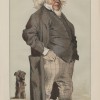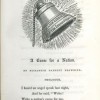
Owen Holland, “‘These Christs that die upon the barricades’: Victorian Responses to the Paris Commune”
The Paris Commune of 1871 provoked several different kinds of reaction in Victorian Britain during the fin de siècle. William Morris and Oscar Wilde (amongst others) celebrated the Commune in their poetry and political writings, re-assessing the event’s meaning in the context of the 1880s socialist revival, while the republicanism of Algernon Charles Swinburne led him to adopt a more hostile attitude in the immediate aftermath of the revolution. Several other writers sought to think through their confusion in response to the Commune, including John Ruskin, Gerard Manley Hopkins and George Gissing, but they all did so against the consistent pressure of conservative reaction, exerted in the form of periodical and newspaper commentary, and sensationalised misrepresentation of the Communards’ deeds and aims. This article surveys some of the main contours of the Commune’s discursive afterlives in Britain, arguing that the British response was characterised by multiple forms of political and aesthetic contestation.

Peter H. Hoffenberg, “1871-1874: The South Kensington International Exhibitions”
The series of annual international exhibitions held during the early 1870s at South Kensington, London, were not particularly successful, or popular, but they were influential in the history of exhibitions. The alleged failures and the cancellation of the final annual exhibition halfway through the intended decade-long series of events provoked considerable discussion about the purpose, scale and expectations for exhibitions, which were no longer novel or limited to a particular city or nation-state. There were some successes, notably for the Australian colonies and British India, and for very specific trades and exhibitors, but the public discussion and those limited successes have generally failed to capture the attention of scholars. These events are rarely mentioned in books and articles about exhibitions and, when discussed, are considered to be failures without merit. This BRANCH contribution recognizes that other exhibitions were more popular and more successful, but also recognizes that the South Kensington shows were significant in addressing criticisms of exhibitions in general and in the generational history of both the shows and their organizers. The 1870s proved to be a pivotal period in the history of such exhibitions and the consideration of what merited public culture. The mantle was passed from Sir Henry Cole to his successors and the ambition of holding annual international exhibitions was replaced by more thematic shows in Britain and bold international shows in the Australian colonies. Amidst the general impressions of failure, there were also successes at the shows and those highlighted how inter-national exhibitions could prove useful in a changing world.

Denae Dyck and Marjorie Stone, “The ‘Sensation’ of Elizabeth Barrett Browning’s Poems before Congress (1860): Events, Politics, Reception”
Elizabeth Barrett Browning’s Poems before Congress paradoxically addresses a political event that never took place: a meeting of European powers to discuss the “Italian question” planned for January of 1860. Nevertheless, the collection addresses several momentous historical developments, including the Second Italian War of Independence in 1859, the intervention of Napoleon III of France in the Italian struggle, and the international conflict his intervention precipitated. Indeed, the book’s publication and the sensation it created in themselves constitute a plurality of events, since the collection appeared under differing titles in England and America and encountered differing responses in each country. Contrary to the still dominant critical view that the volume was almost universally denounced, its reception was shaped by diverse locations, shifting chronological contexts, and conflicting political affiliations. Close analysis of the reviews underscores the importance of these wider contexts, which influence what otherwise appear to be primarily literary or aesthetic judgements. At the same time, analysis of varying responses to not only “A Curse for a Nation” but also “Napoleon III in Italy” and other poems in the volume demonstrates a number of recurring points of contention. These include the collection’s title, the politics of interventions across national borders, English liberalism, the nature of democracy, cosmopolitanism versus nationalism, women writers in relation to politics, poetic form, and, most of all, EBB’s representation of Napoleon III—the issue that is front and centre in most of the 1860s reviews and that shaped, in turn, reactions to all the rest.

Frederick Burwick, “18 June 1815: The Battle of Waterloo and the Literary Response”
Although Europe had celebrated the end of the Napoleonic Wars with the defeat of the French armies and the abdication of the emperor on 11 April 1814, Napoleon escaped and again rallied his troops against the British and Prussian armies. His defeat at Waterloo on 18 June 1815 was the final battle with heavy losses on all sides. The extensive response in the British press was unprecedented. In addition to several military reports of the battle, many civilian eye-witness narratives also appeared. Memoirs, histories, and biographies added to the prose accounts. With contributions from Lord Byron, Sir Walter Scott, Robert Southey, William Wordsworth, and many minor authors, the poetry included both celebrations of the victory and lamentations over the loss of lives. Theatres, too, brought forth numerous spectacles and melodrama. Londoners were also treated to several exhibitions and panorama displaying scenes from the battle (Favret 8-12).

Cheryl A. Wilson, “The Arrival of the Waltz in England, 1812”
The arrival of the waltz in England changed both the experience of participating in the ballroom and the cultural impact of Victorian social dance.

Kristi N. Embry, “The Entente cordiale between England and France, 8 April 1904″
The Entente cordiale was a series of formal political agreements signed in 1904 that negotiated the peace between England and France. French for “warm understanding,” the Entente cordiale of 1904 settled more immediate disputes between England and France in Egypt, Morocco, and elsewhere in Africa. Perhaps more famously, the series of agreements signed in 1904 contributed to the harmonization of relations between the two countries in the twentieth and twenty-first centuries. But, as I show here, the Entente cordiale of 1904 also served as the culmination of a more informal—and precarious—entente that had slowly developed between the former enemies beginning in the 1830s and 1840s.
